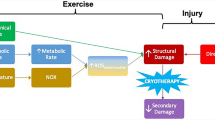Abstract
This study compared metabolic and cardiopulmonary responses to incremental supine and upright sitting arm crank ergometry (ACE) in nine men with spinal cord injured paraplegia ranging from T1–T5. Both tests consisted of continuous graded ACE from rest to volitional fatigue on a modified electronically braked cycle ergometer with the work rate increased by 8.2 W · min−1. No significant differences (P>0.05) existed for peak ACE power output (\(\dot W\)), oxygen uptake, pulmonary ventilation, respiratory exchange ratio, and O2 pulse between the two tests. Heart rate and O2 pulse responses at six submaximal work rates representing 0–58% peak \(\dot W\) were also not significantly different between postures. These data indicate that ACE tolerance in persons with high-lesion paraplegia was not enhanced when ACE was performed in the supine posture.
Similar content being viewed by others
References
Bruin MI de, Binkhorst RA (1984) Cardiac output of paraplegics during exercise. Int J Sports Med (Suppl) 5:175–176
Burkett LN, Chisum J, Stone W, Fernhall B (1990) Exercise capacity of untrained spinal cord injured individuals and the relationship of peak oxygen uptake to level of injury. Paraplegia 28:512–521
Figoni SF, Glaser RM, Gupta SC, Suryaprasad AG (1991) Effects of posture upon physiologic responses of quadriplegics during arm-crank exercise. Med Biol Eng Comp 29:719
Flandrois R, Grandmontagne M, Gerin H, Mayet MH, Jehl JL, Eysette M (1986) Aerobic performance capacity in paraplegic subjects. Eur J Appl Physiol 55:604–609
Glaser RM (1989) Arm exercise training in wheelchair users. Med Sci Sports Exerc 21: S149-S157
Hjeltnes N (1977) Oxygen uptake and cardiac output in graded arm exercise in paraplegics with low level spinal lesions. Scand J Rehabil Med 9:107–113
Hooker SP, Greenwood JD, Hatae DT, Husson RB, Mathiesen TL, Waters AR (1993) Uptake and heart rate relationship in persons with spinal cord injury. Med Sci Sports Exerc 25:1113–1117
Hopman MTE, Oeseburg B, Binkhorst RA (1992) The effect of an anti-G suit on cardiovascular responses to exercise in persons with paraplegia. Med Sci Sports Exerc 24:984–990
Hopman MTE, Oeseburg B, Binkhorst RA (1993) Cardiovascular responses in persons with paraplegia to prolonged arm exercise and thermal stress. Med Sci Sports Exerc 25:577–583
Jehl JL, Grandmontagne M, Pastene G, Eysette M, Flandrois R, Coudert J (1991) Cardiac output during exercise in paraplegic subjects. Eur J Appl Physiol 62:256–260
McLean JL, Jones PP, Skinner JS (1992) Heart rate/\(\dot V\)O2 relationship in exercising quadriplegics. Med Sci Sports Exerc (Suppl) 240: S17
Saltin B, Strange SL (1992) Maximal oxygen uptake: “old” and “new” arguments for a cardiovascular limitation. Med Sci Sports Exerc 24:30–37
Author information
Authors and Affiliations
Rights and permissions
About this article
Cite this article
Hooker, S.P., Greenwood, J.D., Boyd, L.A. et al. Influence of posture on arm exercise tolerance and physiologic responses in persons with spinal cord injured paraplegia. Europ. J. Appl. Physiol. 67, 563–566 (1993). https://doi.org/10.1007/BF00241655
Accepted:
Issue Date:
DOI: https://doi.org/10.1007/BF00241655




